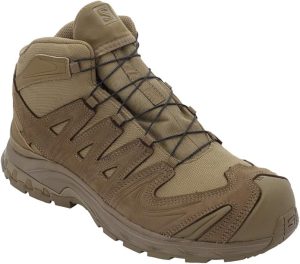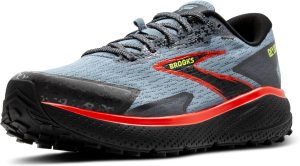Ask any experienced rucker, and you will get the same answer: your feet are the real MVPs of rucking.
Why? They bear the load, take the hits, and carry you mile after mile—so they deserve some profound love. The right footwear can make rucking a joy, while the wrong pair can turn it into a painful slog filled with blisters, aches, and regret.
Whether you’re brand new to rucking or a seasoned pro, understanding what to look for in the best rucking shoes or boots for you is key. In this guide, we’ll break down why footwear matters, what features to prioritize, and which specific models to consider.

Why Footwear Matters for Rucking
When you’re rucking, you’re not just walking—you’re carrying weight, often across uneven terrain. That added weight changes everything about how your body moves, making proper footwear absolutely critical. Here’s why:
1. Protection and Support
Rucking involves extra pressure on your feet, knees, and back. A solid pair of boots or shoes protect your feet from the ground below (think sharp rocks or roots) while offering stability to prevent injuries like rolled ankles. For heavier rucks, this support is non-negotiable.
Many people will start rucking in their old tennis shoes, minimal sneakers, or even crocs or sandals. This can be very dangerous and can easily lead to injury. Start with more support and then dial down as you feel comfortable and get your form down.
2. Comfort for the Long Haul
Let’s get real: nothing will ruin your ruck faster than blisters or foot fatigue. Properly cushioned, supportive footwear helps keep you comfortable for the duration. You want shoes that cradle your feet, absorb impact, and don’t cause painful hot spots.
3. Injury Prevention
The repetitive stress of walking with weight can take a toll on your body, especially if your shoes aren’t pulling their weight (pun intended). Proper footwear can help stave off issues like shin splints, plantar fasciitis, or knee pain by providing the right level of support and shock absorption.
4. Traction
Rucking isn’t always on a neatly paved path. You’ll often face mud, rocks, or loose dirt. Good traction prevents slips and keeps you stable, even when the terrain gets sketchy.

What to Look for in Rucking Shoes
Not all boots and shoes are created equal, especially when it comes to rucking. Here’s what to prioritize:
1. Fit is Everything
Your shoes might have every bell and whistle, but if they don’t fit right, you’re in for a rough ride. Here’s how to get it right:
- Roomy Toe Box: Your toes should have space to wiggle and splay naturally, especially since your feet swell during long rucks.
- Snug Heel: Your heel should stay locked in place with no slipping—blisters love loose heels.
- Flex Point Alignment: The shoe should bend where your foot naturally flexes, typically at the ball of your foot.
2. Cushioning and Shock Absorption
Rucking adds weight, which increases the impact on your feet with every step. Shoes with proper cushioning absorb that impact, reducing strain on your feet and joints.
The heel-to-toe drop, or the difference in height between the heel and the forefoot, impacts your stride. For rucking:
- High Drop (8-12mm): Provides more cushioning and is easier on the Achilles tendon, making it good for beginners.
- Low Drop (0-6mm): Offers a more natural stride and is often favored by experienced ruckers.
3. Durability
Your footwear has to handle the wear and tear of weighted rucks, often over tough terrain. Look for:
- Sturdy Uppers: Materials like nylon mesh, full-grain leather, or a combination are durable yet breathable.
- Reinforced Stitching: Prevents seams from busting under stress.
- Protective Toe Caps: Guards against rocks and general wear.
4. Traction
Slipping on a trail (or a wet sidewalk) while carrying a loaded rucksack is no joke. Make sure your shoes are equipped for the terrain you’ll face:
- Aggressive Lugs: Deep lugs work great for muddy or loose trails, while moderate lugs are better for mixed or urban environments.
- High-Quality Rubber Outsoles: Materials like Vibram® provide excellent grip in all conditions.
5. Breathability and Waterproofing
The environment you ruck in will dictate what’s more important—ventilation or waterproofing.
- Hot, Dry Climates: Prioritize breathability to keep your feet cool and dry.
- Wet or Rainy Conditions: Opt for waterproof membranes like Gore-Tex. If you anticipate water crossings, look for shoes with drainage ports to shed water quickly.
6. Ankle Support
For lighter loads and smoother terrain, low-cut trail runners might suffice. But if you’re hauling heavy loads or tackling rocky trails, mid- or high-cut boots provide the ankle support you need to prevent injuries.
7. Break-in Time
Rucking shoes that feel good out of the box are ideal, but most high-quality options will need a little breaking in. Start with shorter walks to get the fit dialed in before going the distance.
8. Weight
Heavy boots are great for protection and support, but they can slow you down over long distances. Lightweight trail runners, on the other hand, are nimble but might not provide enough durability for rugged or long rucks. Strike a balance based on your typical load and terrain.

Hiking Boots vs. Trail Running Shoes: Which is Best?
The choice between hiking boots and trail running shoes depends on your rucking style, terrain, and goals:
- Hiking Boots: Best for rugged terrain, heavy loads, and extended trips. They offer more ankle support and durability but are heavier.
- Trail Running Shoes: Perfect for speed rucks or moderate loads on well-maintained trails. They’re lightweight and breathable but may lack the durability of boots.
My Take: If you’re just starting out, go with hiking boots. They offer more support and are forgiving when your form isn’t perfect. Trail runners are great once you’ve built up experience and know your limits.
My Top Picks for Rucking Footwear
Here are some battle-tested options for ruckers of all levels:

Salomon Men’s Xa Forces
A tactical beast with excellent durability, waterproofing, and ankle support.

ALTRA Men’s Lone Peak 8
Lightweight and breathable with a wide toe box, ideal for trail running enthusiasts.

Garmont T8 Bifida
Military-grade durability with solid grip and support, great for heavy-duty rucks.

Merrell Moab 3 Mid
A reliable all-rounder for mixed terrain, offering comfort and traction.

Brooks Men’s Divide 5
Lightweight trail runners with superb cushioning for urban and trail rucks.
Final Thoughts: Invest in Your Feet
Your footwear is the most important piece of gear you’ll invest in for rucking. A good pair of shoes or boots will make your rucks more enjoyable, protect you from injuries, and help you go farther with less pain. Don’t settle for cheap or ill-fitting footwear—your feet deserve better.
So, head to your local outfitter, try on a few pairs, and take your time finding the perfect match. Trust me, your feet will thank you after those first few miles. Lace up, load your ruck, and hit the trail—you’re ready to crush it!



